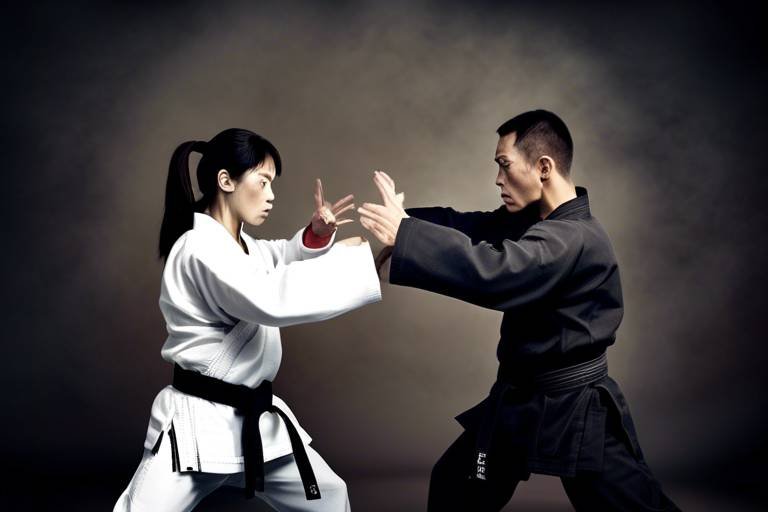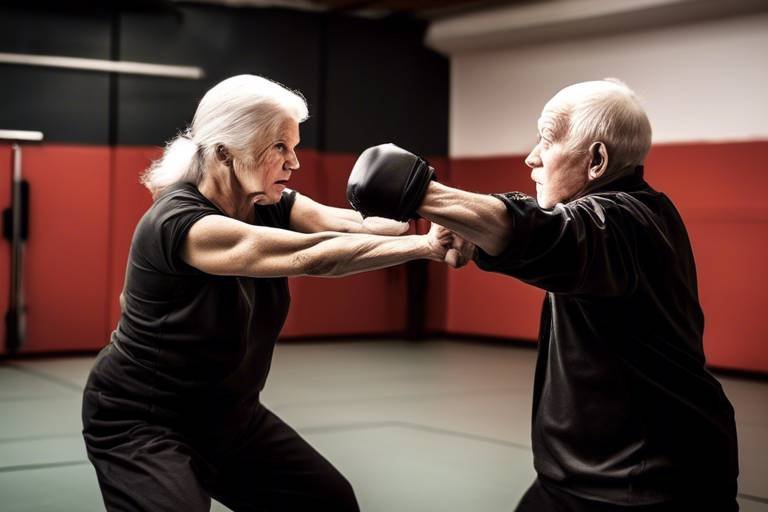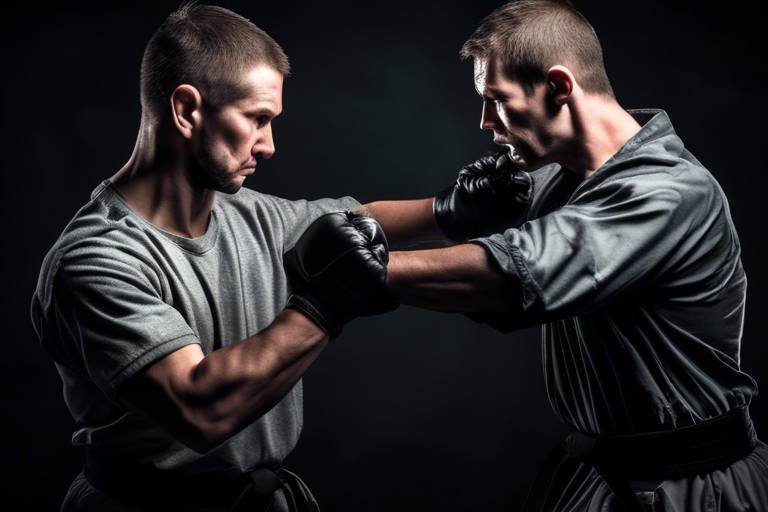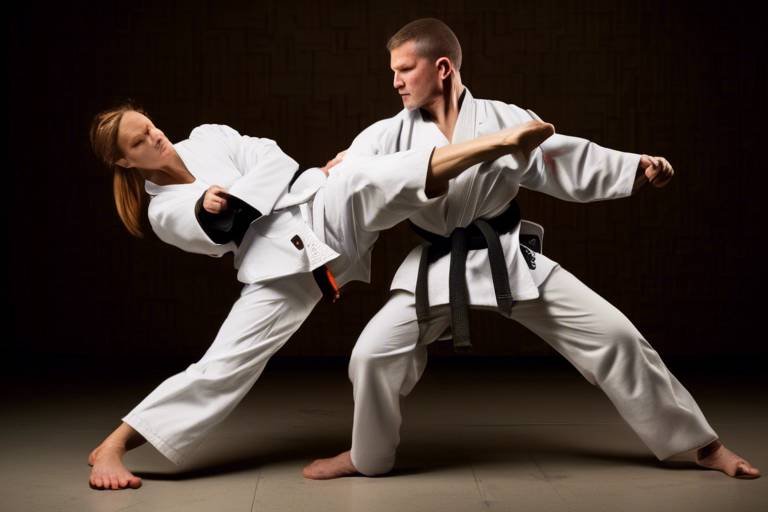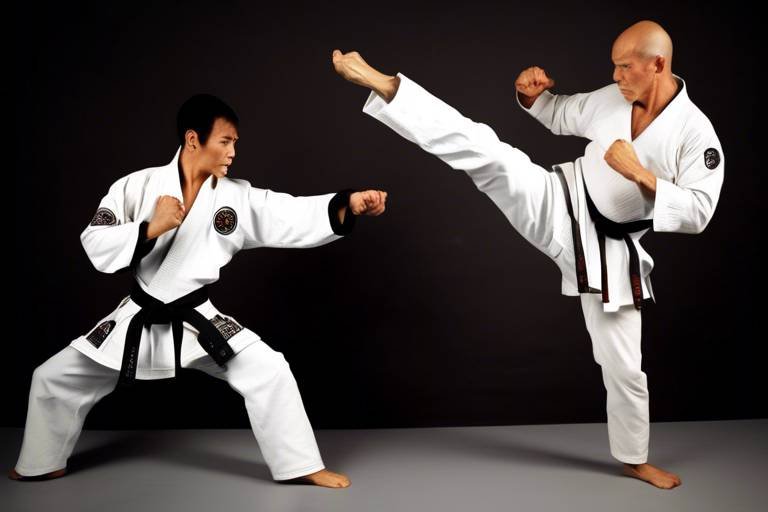The Impact of Body Type on Self-Defense Techniques
When it comes to self-defense, one size definitely does not fit all. Your body type can play a crucial role in determining which self-defense techniques will work best for you. Understanding this can mean the difference between effectively defending yourself and struggling to apply techniques that don’t suit your physique. The reality is that each body type—ectomorph, mesomorph, and endomorph—brings its own unique strengths and weaknesses to the table. So, let’s dive into how these body types influence self-defense strategies and how you can tailor your approach for optimal safety and performance.
Body types can be categorized into three main classifications: ectomorph, mesomorph, and endomorph. Each type has distinct physical characteristics that can affect self-defense abilities and techniques. Ectomorphs are generally lean and tall, often possessing a slender build that allows for quick movement. Mesomorphs, on the other hand, are typically muscular and athletic, making them versatile in various physical activities. Endomorphs tend to have a rounder physique with more muscle mass, which can provide strength but might come at the cost of agility. Understanding these distinctions is the first step toward leveraging your body type in self-defense scenarios.
Physical strength and agility are foundational elements in self-defense. Depending on your body type, these attributes can vary significantly. For instance, while an endomorph may have an advantage in sheer strength, an ectomorph might excel in agility and quick reflexes. It’s essential to recognize how these physical traits influence your self-defense effectiveness. In high-pressure situations, having a clear understanding of your strengths can empower you to react more confidently and efficiently. Remember, self-defense is not just about brute strength; it’s also about strategy, timing, and knowing when to engage or evade.
Endomorphs typically possess greater muscle mass, which can provide significant advantages in certain self-defense scenarios. Their physicality allows them to engage in techniques that require strength, such as grappling or holding an opponent in place. This section discusses how their physicality can be leveraged in confrontational situations. For example, an endomorph can utilize their weight to maintain a strong base during a confrontation, making it difficult for an opponent to throw them off balance. This ability to ground themselves can be crucial when facing an aggressor.
Weight can be an asset in self-defense. Techniques such as joint locks and throws can be particularly effective for endomorphs. By knowing how to use their body weight to their advantage, they can apply pressure to an opponent’s joints or leverage their mass to execute effective throws. This section emphasizes grounding and stability, which are vital in self-defense scenarios. For instance, when an endomorph is confronted, they can adopt a low stance, making it harder for an opponent to lift or throw them. This grounding technique not only enhances stability but also allows for powerful counterattacks.
Despite their strength, endomorphs may face challenges in agility. While they can hold their ground effectively, their heavier build might limit their speed and quickness. This part addresses potential limitations and how to overcome them in self-defense situations. For example, endomorphs should focus on techniques that allow them to use their strength while minimizing the need for rapid movement. Practicing defensive maneuvers that involve blocking and countering rather than evading can help them navigate confrontations more effectively.
Mesomorphs are often characterized by their athletic build, which offers versatility in self-defense techniques. Their combination of strength and agility allows them to adapt to various self-defense scenarios. Whether it’s executing a quick jab or a powerful takedown, mesomorphs can switch between techniques with relative ease. This section highlights the adaptability of mesomorphs in various self-defense situations, allowing them to respond to threats with a balanced approach. Their athleticism enables them to perform a wide range of techniques effectively, making them formidable opponents in confrontational situations.
Ectomorphs are typically lean and agile, which influences their self-defense approach. This section focuses on techniques that capitalize on speed and flexibility for effective defense. Ectomorphs should embrace their natural advantages by focusing on techniques that allow them to evade attacks and strike quickly. Their slender build can be leveraged to slip away from grips and use rapid movements to create distance from an aggressor.
Speed is a significant advantage for ectomorphs. This subsection discusses how they can use rapid movements and evasive techniques to avoid confrontation. Quick footwork, for example, can help ectomorphs dodge attacks and create openings for counterattacks. By practicing footwork drills and agility exercises, they can enhance their ability to move swiftly and unpredictably, making it challenging for an opponent to land a hit. This approach transforms them into elusive targets, allowing them to escape or outmaneuver aggressors effectively.
Ectomorphs can benefit from maintaining distance in self-defense situations. This part explores strategies for creating space and using it to their advantage. By understanding the importance of distance, ectomorphs can keep aggressors at bay, making it harder for them to engage effectively. Techniques such as jabs and kicks can be employed to maintain space, allowing ectomorphs to strike while staying out of reach. This strategic use of distance not only enhances their defensive capabilities but also empowers them to control the pace of the encounter.
- Can I improve my self-defense skills regardless of my body type? Absolutely! While your body type may influence your strengths and weaknesses, anyone can improve their self-defense skills through practice and training.
- What if I don't fit neatly into one body type? Many people have characteristics of multiple body types. Focus on your unique attributes and tailor your self-defense techniques accordingly.
- Are there specific martial arts that suit different body types? Yes! Some martial arts emphasize strength, while others focus on speed and agility. Researching various styles can help you find the best fit for your body type.

Understanding Body Types
This article explores how different body types influence the effectiveness of various self-defense techniques, highlighting the importance of tailoring strategies to individual physical attributes for optimal safety and performance.
Body types can be categorized into three main classifications: ectomorph, mesomorph, and endormorph. Each type has distinct physical characteristics that can affect self-defense abilities and techniques. Understanding these classifications is crucial for anyone looking to enhance their self-defense skills, as it allows individuals to identify their strengths and weaknesses.
The ectomorph is typically characterized by a lean and slender frame. These individuals often have long limbs and minimal body fat, which can contribute to their agility. However, their lack of muscle mass may limit their physical strength in confrontational situations. Ectomorphs may excel in techniques that emphasize speed and evasion, allowing them to avoid potential threats rather than confront them head-on.
On the other hand, the mesomorph body type is often seen as the ideal athletic build. With a naturally muscular physique, mesomorphs possess a combination of strength and agility. This versatility makes them well-suited for a wide range of self-defense techniques, from grappling to striking. Their ability to adapt to various situations can be a significant advantage in self-defense scenarios.
Finally, we have the endormorph, known for their broader frame and higher levels of body fat. While they may not be as agile as their ectomorphic counterparts, endomorphs typically possess greater muscle mass, which can be leveraged in self-defense situations. Their physicality can provide advantages in terms of grounding and stability, allowing them to apply techniques that utilize their weight effectively.
In summary, recognizing your body type can empower you to tailor your self-defense strategies accordingly. By understanding the strengths and limitations of each classification, individuals can make informed choices about which techniques to focus on and how to optimize their performance in self-defense scenarios.
- What is the best self-defense technique for my body type? It depends on whether you are an ectomorph, mesomorph, or endomorph. Each type has techniques that play to their strengths.
- Can I improve my self-defense skills regardless of my body type? Absolutely! Training can enhance your abilities and help you utilize your body type effectively.
- Are there specific training programs for different body types? Yes, many self-defense programs offer tailored training that considers individual body types and their unique strengths.

Physical Strength and Agility
When it comes to self-defense, the interplay between physical strength and agility is nothing short of fascinating. Each body type brings its own unique advantages and challenges to the table, influencing how effectively one can defend themselves in a potentially dangerous situation. For instance, consider how a heavyweight boxer relies on their strength to deliver powerful punches, while a skilled gymnast uses their agility to evade attacks. These contrasting approaches highlight the importance of understanding one’s physical attributes and tailoring self-defense strategies accordingly.
Physical strength is often perceived as the cornerstone of self-defense. It allows individuals to overpower an opponent, execute techniques with force, and maintain control during a confrontation. However, strength alone is not sufficient. Agility—the ability to move quickly and easily—plays a crucial role in dodging attacks, repositioning oneself, and executing techniques that require finesse. The combination of these two attributes can significantly enhance a person's self-defense capabilities.
Let’s break down how each body type experiences these elements differently:
| Body Type | Strength Characteristics | Agility Characteristics |
|---|---|---|
| Ectomorph | Generally less muscle mass, but can be quick and nimble. | High agility, excels in speed and evasiveness. |
| Mesomorph | Well-developed muscle mass, combines strength with physical prowess. | Good balance of strength and agility, adaptable in techniques. |
| Endomorph | Greater muscle mass, often stronger in grappling situations. | May struggle with agility, but can use weight to their advantage. |
Understanding these differences can help individuals choose the right self-defense techniques. For instance, an ectomorph might focus on speed and evasive maneuvers, while an endomorph could concentrate on leveraging their weight in grappling techniques. Moreover, mesomorphs can enjoy the best of both worlds, adapting their strategies to fit the situation at hand.
In terms of training, it’s essential for individuals to engage in exercises that enhance both strength and agility. This can include weight training for building muscle mass and plyometric exercises for improving quickness and coordination. By developing both attributes, a person can create a more well-rounded self-defense skill set that prepares them for various scenarios.
Ultimately, the key takeaway is that understanding one's body type can lead to more effective self-defense strategies. By recognizing the strengths and limitations associated with physical attributes, individuals can tailor their training and techniques to maximize their potential in self-defense situations.
- How can I determine my body type? You can determine your body type by assessing your physical characteristics, such as muscle mass, body fat percentage, and overall build. Various online quizzes can also help categorize your body type.
- What self-defense techniques are best for my body type? It depends on your body type. Ectomorphs should focus on speed and evasion, mesomorphs can adapt to various techniques, and endomorphs should leverage their strength in grappling.
- Is it possible to change my body type? While your genetic predisposition plays a significant role, you can modify your physique through targeted training and nutrition to enhance your strengths and mitigate weaknesses.

Endomorph Strength Advantages
When it comes to self-defense, understanding the unique strengths of different body types is crucial, and endormorphs have some distinct advantages that can be incredibly beneficial in confrontational situations. With their naturally higher muscle mass and broader frames, endomorphs often possess the ability to exert more force in physical encounters. This physicality can be a game changer when it comes to self-defense techniques that require strength and stability.
One of the key advantages of endomorphs is their inherent strength, which allows them to perform techniques that rely on brute force. For instance, in grappling situations, an endomorph's weight and muscle can make it difficult for an opponent to gain the upper hand. Imagine a sturdy tree standing against a strong wind; that’s how endomorphs can leverage their physicality to maintain control during an altercation. Their ability to push back against an opponent’s force can create a significant advantage, allowing them to dominate in close-range encounters.
Moreover, endomorphs can utilize their weight effectively in various self-defense techniques. Techniques that involve grounding and stability, such as joint locks or throws, can be particularly effective for individuals with a heavier build. Their center of gravity tends to be lower, which enhances their balance and makes it easier to execute these techniques without losing footing. For example, when applying a hip throw, an endomorph can use their weight to unbalance an opponent, making it easier to execute the move successfully.
However, it’s important to note that while endomorphs have these strengths, they also face certain challenges. Agility can sometimes be a limitation due to their heavier frames. But this doesn’t mean that endomorphs can't excel in self-defense; they simply need to adapt their techniques accordingly. By focusing on strength-based strategies and incorporating flexibility training, endomorphs can enhance their overall effectiveness in self-defense scenarios.
In summary, the strength advantages of endomorphs make them formidable opponents in self-defense situations. By capitalizing on their muscle mass and stability, they can effectively use various techniques to protect themselves. The key lies in understanding these strengths and adapting self-defense strategies to align with their physical attributes.
- What is an endomorph body type? An endomorph body type is characterized by a higher percentage of body fat, a wider waist, and a larger bone structure, which often leads to greater muscle mass.
- How can endomorphs improve their agility for self-defense? Endomorphs can improve agility through targeted flexibility and conditioning training, which can help them move more fluidly during confrontations.
- What self-defense techniques are best for endomorphs? Techniques that emphasize strength, such as grappling, joint locks, and throws, are particularly effective for endomorphs due to their natural strength and stability.

Utilizing Weight in Techniques
When it comes to self-defense, the concept of weight isn't just about being heavy; it's about how one can effectively leverage their body mass to gain an advantage in a confrontation. For individuals with an endomorphic body type, this can be particularly beneficial. Their greater muscle mass and overall weight can be utilized in various self-defense techniques, allowing them to dominate in close combat situations. Imagine being a sturdy oak tree in a storm, where your weight and strength help you withstand the winds of confrontation.
One of the key aspects of utilizing weight in self-defense is the ability to ground oneself. This means using your body weight to create a solid base, making it harder for an opponent to move you or throw you off balance. Techniques such as grappling or clinching can be particularly effective for endomorphs. By anchoring themselves and using their weight, they can apply pressure on their opponent, making it difficult for them to escape or counterattack. Think of it like a boulder rolling down a hill; once it gains momentum, it’s hard to stop.
Moreover, endomorphs can employ specific techniques that capitalize on their weight advantage. For example, when executing a takedown, they can use their body mass to their benefit by shifting their weight into the opponent, making it more challenging for the latter to regain their footing. This is akin to a heavyweight boxer leaning into a punch, using their body to maximize impact. Here are a few techniques that endomorphs might consider:
- Body Lock: This technique allows the individual to wrap their arms around the opponent, using their weight to apply pressure and control the situation.
- Hip Throw: By using their hips as a pivot point, endomorphs can leverage their weight to throw an opponent off balance effectively.
- Ground and Pound: Once on the ground, endomorphs can use their weight to control their opponent while delivering strikes, making it difficult for the opponent to escape.
However, while there are many advantages to utilizing weight, it's essential to recognize the potential limitations that come with it. Endomorphs may sometimes find themselves at a disadvantage when it comes to agility and speed. To counteract this, they should focus on training techniques that enhance their mobility while still capitalizing on their weight. Incorporating flexibility and quick footwork into their training regimen can help them become more well-rounded self-defense practitioners.
In conclusion, utilizing weight in self-defense is not just about brute force; it's about strategy and technique. By understanding how to effectively use their body mass, endomorphs can turn what might seem like a limitation into a powerful asset. It’s all about finding the right balance and knowing when and how to apply that weight to achieve the best results in self-defense scenarios.
- What are the advantages of being an endomorph in self-defense? Endomorphs typically have greater muscle mass, allowing them to leverage their weight in techniques such as grappling and clinching.
- Can endomorphs improve their agility for self-defense? Yes, by incorporating flexibility and agility training into their regimen, endomorphs can enhance their overall self-defense capabilities.
- What techniques should ectomorphs focus on in self-defense? Ectomorphs should prioritize techniques that emphasize speed, distance management, and evasive movements to capitalize on their agility.

Limitations of Endomorphs
This article explores how different body types influence the effectiveness of various self-defense techniques, highlighting the importance of tailoring strategies to individual physical attributes for optimal safety and performance.
Body types can be categorized into three main classifications: ectomorph, mesomorph, and endomorph. Each type has distinct physical characteristics that can affect self-defense abilities and techniques.
Physical strength and agility play crucial roles in self-defense. This section examines how different body types impact these attributes and the implications for self-defense effectiveness.
Endomorphs typically possess greater muscle mass, providing advantages in certain self-defense scenarios. This section discusses how their physicality can be leveraged in confrontational situations.
Weight can be an asset in self-defense. This subsection explores techniques that endomorphs can use to their advantage, emphasizing grounding and stability.
While endomorphs have their strengths, they also face some significant limitations when it comes to self-defense. One of the primary challenges is their agility. Due to their larger frame and muscle mass, endomorphs may find it difficult to execute quick movements or dodge attacks effectively. This can be a considerable disadvantage in high-pressure situations where speed is essential.
Moreover, their center of gravity, which is often lower due to their body composition, can make certain techniques, such as jumping or rapid lateral movements, more challenging. This can lead to a reliance on strength rather than technique, which may not always be the best approach in self-defense scenarios.
Additionally, endurance can be a concern. Endomorphs may tire more quickly than their ectomorph or mesomorph counterparts, especially in prolonged confrontations. This fatigue can diminish their effectiveness in a self-defense situation. To combat these limitations, endomorphs should focus on:
- Improving cardiovascular health through regular aerobic exercises.
- Incorporating flexibility training to enhance their range of motion.
- Practicing specific self-defense techniques that require less agility but leverage their strength.
By acknowledging these limitations and actively working to improve their agility and endurance, endomorphs can become more effective in self-defense scenarios. It's all about finding the right balance between utilizing their natural strengths and addressing their weaknesses.
Mesomorphs are often characterized by their athletic build, which offers versatility in self-defense techniques. This section highlights the adaptability of mesomorphs in various self-defense scenarios.
Ectomorphs are typically lean and agile, which influences their self-defense approach. This section focuses on techniques that capitalize on speed and flexibility for effective defense.
Speed is a significant advantage for ectomorphs. This subsection discusses how they can use rapid movements and evasive techniques to avoid confrontation.
Ectomorphs can benefit from maintaining distance in self-defense situations. This part explores strategies for creating space and using it to their advantage.
- Can endomorphs be effective in self-defense despite their limitations?
Absolutely! By focusing on their strengths and improving areas like agility and endurance, endomorphs can become proficient in self-defense techniques. - What exercises can help endomorphs improve their agility?
Incorporating agility drills, plyometrics, and flexibility training into their workout routine can significantly enhance their movement skills. - Are there specific self-defense techniques better suited for endomorphs?
Yes, techniques that leverage strength, such as grappling or ground fighting, can be particularly effective for endomorphs.

Mesomorphs and Versatility
When it comes to self-defense, mesomorphs truly shine with their unique blend of strength, agility, and endurance. These individuals, often characterized by their muscular build and athletic physique, are naturally predisposed to excel in various physical activities, including self-defense techniques. Their bodies are like finely tuned machines, capable of adapting to different situations, which makes them incredibly versatile in confrontational scenarios.
One of the key advantages of mesomorphs is their ability to switch between offensive and defensive strategies with ease. This adaptability allows them to respond effectively to a range of threats, whether they need to engage an opponent directly or evade a potentially dangerous situation. Mesomorphs can utilize their strength to overpower an aggressor or employ their agility to dodge attacks, making them formidable opponents in any self-defense situation.
Moreover, mesomorphs often possess a natural sense of balance and coordination, which enhances their overall performance in self-defense techniques. This balance is crucial when executing moves that require precise timing and positioning. For instance, a mesomorph might find it easier to perform a swift kick or a powerful punch, leveraging their body weight effectively to maximize impact. Their physicality allows them to maintain control even in high-pressure situations, which is essential for effective self-defense.
In addition to their physical attributes, mesomorphs can benefit from a well-rounded training regimen that focuses on various self-defense techniques. For example, incorporating elements of martial arts, boxing, or even functional fitness can enhance their skills and prepare them for different confrontational scenarios. A diverse training approach not only builds strength but also improves flexibility and reaction time, further enhancing their versatility.
To illustrate the versatility of mesomorphs in self-defense, consider the following table that highlights some effective techniques suited for their body type:
| Technique | Description | Advantages |
|---|---|---|
| Striking Techniques | Utilizing punches and kicks to create distance or incapacitate an attacker. | High impact due to muscle mass; effective for quick takedowns. |
| Grappling Techniques | Using holds and locks to control or subdue an opponent. | Leverage strength and balance for dominant positions. |
| Evasive Maneuvers | Dodging or redirecting attacks to avoid confrontation. | Agility allows for quick escapes and counter-attacks. |
In conclusion, mesomorphs are uniquely equipped for self-defense due to their physical attributes and adaptability. By leveraging their strengths and incorporating a variety of techniques into their training, they can enhance their self-defense skills and effectively navigate confrontational situations. The versatility of a mesomorph not only empowers them in self-defense scenarios but also boosts their confidence, enabling them to face potential threats head-on.
- What are the main characteristics of mesomorphs?
Mesomorphs typically have a muscular build, broad shoulders, and a naturally athletic physique, which aids in physical activities. - How can mesomorphs improve their self-defense skills?
By engaging in diverse training methods, including martial arts and functional fitness, mesomorphs can enhance their strength, agility, and overall technique. - Are there specific self-defense techniques that work better for mesomorphs?
Techniques that leverage strength and balance, such as striking and grappling, are particularly effective for mesomorphs. - Can mesomorphs adapt to different self-defense situations?
Yes, their versatility allows them to switch strategies based on the circumstances, making them effective in various confrontational scenarios.

Techniques for Ectomorphs
Ectomorphs, often characterized by their lean physique and heightened agility, have a unique advantage in self-defense scenarios. Their body type allows them to move quickly and evade attacks, making speed their greatest ally. Imagine a gazelle darting away from a predator; that's the kind of agility ectomorphs can harness in a confrontation. Instead of relying on brute strength, these individuals can utilize their natural attributes to navigate self-defense situations effectively.
One of the key techniques for ectomorphs is leveraging their speed and agility. This means mastering quick footwork and developing the ability to change direction rapidly. For instance, practicing drills that enhance lateral movement can be incredibly beneficial. Ectomorphs can also excel in techniques that require swift strikes or evasive maneuvers. Think of a boxer dodging punches or a dancer performing intricate footwork—this is the kind of finesse that ectomorphs can bring to their self-defense tactics.
Moreover, maintaining distance is crucial for ectomorphs. By keeping a safe space between themselves and an aggressor, they can avoid being overpowered. This can be achieved through techniques such as using footwork to create space and employing defensive stances that allow for quick retreats. For example, an ectomorph might use a jab to keep an opponent at bay while simultaneously positioning themselves to escape if necessary. This strategy not only helps in avoiding direct confrontation but also gives them the opportunity to regroup and reassess the situation.
Additionally, ectomorphs should focus on developing their strategic awareness. Understanding the dynamics of a confrontation can provide a significant advantage. This includes recognizing when to engage, when to retreat, and how to use the environment to their benefit. For instance, if they find themselves in a confined space, they might look for opportunities to maneuver around obstacles, creating a tactical advantage over a larger opponent.
Incorporating specific training techniques can further enhance an ectomorph's self-defense capabilities. Here are a few suggested practices:
- Speed Drills: Engage in exercises that focus on quick sprints and rapid changes in direction.
- Evasion Techniques: Practice slipping and ducking to avoid strikes while maintaining balance.
- Distance Management: Train to recognize and maintain optimal distances during sparring sessions.
By embracing their natural strengths and honing their skills, ectomorphs can transform their body type into a powerful asset in self-defense situations. They may not have the bulk of an endomorph or the muscularity of a mesomorph, but their unique attributes can be just as effective when used strategically.
Q: What are the best self-defense techniques for ectomorphs?
A: Ectomorphs should focus on speed, agility, and distance management techniques. Quick footwork and evasive maneuvers are essential for their self-defense strategy.
Q: Can ectomorphs effectively defend themselves against larger opponents?
A: Yes! By utilizing their agility and strategic distance, ectomorphs can outmaneuver larger opponents and create opportunities to escape or counterattack.
Q: How can an ectomorph improve their self-defense skills?
A: Regular training in speed drills, evasive techniques, and situational awareness can greatly enhance an ectomorph's self-defense abilities.

Leveraging Speed and Agility
When it comes to self-defense, speed and agility are like having a superpower, especially for ectomorphs. These individuals, often characterized by their lean and slender physiques, can maneuver quickly and effectively in high-pressure situations. Imagine a gazelle darting away from a predator; that's the kind of quickness ectomorphs can harness during an altercation. Instead of relying on brute strength, they can use their natural advantages to evade attacks and create openings for counter-moves.
One of the most effective strategies for ectomorphs is to focus on their ability to move swiftly. This means practicing techniques that emphasize rapid footwork and quick reflexes. For instance, mastering lateral movements can help them dodge incoming strikes, allowing them to reposition themselves for a counterattack. The key here is to stay light on their feet, almost like a dancer, which can make a significant difference when facing a larger opponent.
Moreover, utilizing evasive maneuvers can be a game changer. Instead of standing their ground, ectomorphs should aim to keep moving. This could involve techniques such as:
- Side-stepping: Quickly moving to the side to avoid an attack can create an opportunity for a counterstrike.
- Pivoting: Turning on the balls of their feet to change direction swiftly can help them escape a tight spot.
- Rolling: Learning how to roll away from an attack can not only evade the danger but also position themselves for a counter.
Another important aspect of leveraging speed and agility is the strategic use of distance. Ectomorphs can maintain a safe distance from an aggressor, making it harder for them to land a hit. By keeping their opponents at bay, they can create opportunities to strike without putting themselves in harm's way. This approach is akin to a chess game, where maintaining the right distance can lead to a checkmate.
In addition to these techniques, practicing breath control and mental focus can enhance performance. When ectomorphs stay calm and centered, they can react more quickly and make better decisions during a confrontation. It’s essential to remember that self-defense is not just about physical prowess; it’s also about mental agility and awareness of one’s surroundings.
To sum it up, ectomorphs can leverage their speed and agility to navigate self-defense scenarios effectively. By honing their quick reflexes, practicing evasive techniques, and maintaining strategic distance, they can turn potential threats into opportunities for escape or counteraction. In essence, their body type, while different from others, offers unique advantages that, when properly utilized, can lead to successful self-defense outcomes.
- What are the best self-defense techniques for ectomorphs? Ectomorphs should focus on speed, agility, and evasive maneuvers. Techniques that allow them to maintain distance and avoid confrontation are ideal.
- How can ectomorphs improve their self-defense skills? Regular practice of footwork drills, evasive techniques, and breath control exercises can significantly enhance their self-defense capabilities.
- Is strength training important for ectomorphs in self-defense? While strength training is beneficial, ectomorphs should prioritize agility and speed over sheer strength, as their body type excels in those areas.

Strategic Use of Distance
When it comes to self-defense, the concept of distance can be a game changer, especially for ectomorphs who often possess a leaner physique. Imagine being a gazelle in the wild, where your speed and agility allow you to evade predators. This analogy perfectly captures the essence of how ectomorphs can leverage their natural attributes in self-defense situations. By maintaining distance, they can create a buffer zone that enhances their safety while also providing them with time to react and strategize.
One of the primary advantages of keeping distance is that it allows ectomorphs to utilize their agility. Quick footwork can help them dodge potential attacks, much like a skilled dancer gracefully avoiding a partner’s misstep. For instance, when faced with an aggressor, an ectomorph can sidestep, pivot, or even retreat momentarily to reassess the situation. This strategic movement not only keeps them out of harm's way but also positions them for a counterattack when the moment is right.
Moreover, it’s essential for ectomorphs to understand the different ranges of combat. Here's a quick breakdown:
| Combat Range | Description | Best Techniques |
|---|---|---|
| Close Range | Distance where the attacker can reach you with a punch. | Blocking, trapping, or grappling. |
| Medium Range | Distance where kicks can be delivered. | Using kicks, jabs, and quick strikes. |
| Long Range | Distance where you can evade easily. | Footwork, feints, and quick retreats. |
By identifying these ranges, ectomorphs can effectively dictate the pace of an encounter. For example, if they find themselves too close to an aggressor, they can use their speed to create space, transitioning from close to medium or even long range. This not only minimizes the risk of being struck but also allows them to set up for a more favorable position.
Additionally, understanding the environment can greatly enhance their ability to maintain distance. Whether it’s a crowded street or a wide-open park, ectomorphs should be aware of their surroundings and use obstacles to their advantage. For instance, moving behind a parked car or utilizing walls can provide crucial seconds to escape or regroup. Remember, in self-defense, it’s not just about how strong you are; it’s about how smart you can be.
Lastly, practicing distance management through drills can significantly improve an ectomorph's self-defense capabilities. Regular sparring sessions that focus on maintaining distance, combined with agility drills, can hone their reflexes and enhance their ability to read an opponent's movements. After all, in the world of self-defense, being proactive rather than reactive can make all the difference.
- How can ectomorphs improve their self-defense skills?
By focusing on agility and distance management, ectomorphs can leverage their natural advantages. Regular practice and drills can also enhance their reflexes. - What techniques are best for maintaining distance?
Techniques such as footwork, feints, and using environmental obstacles can help ectomorphs keep a safe distance from aggressors. - Is strength training beneficial for ectomorphs?
While ectomorphs may not have the same muscle mass as other body types, incorporating strength training can enhance their overall performance and confidence in self-defense situations.
Frequently Asked Questions
-
How does my body type affect my self-defense techniques?
Your body type plays a significant role in determining which self-defense techniques may be most effective for you. For instance, endomorphs may excel in techniques that leverage their strength and weight, while ectomorphs might benefit from speed and agility. Understanding your unique physical attributes can help you tailor your self-defense strategies for optimal effectiveness.
-
What are the three main body types?
The three main body types are ectomorph, mesomorph, and endomorph. Ectomorphs are typically lean and agile, mesomorphs have a muscular and athletic build, and endomorphs tend to have a rounder physique with more body mass. Each type has its own advantages and challenges when it comes to self-defense techniques.
-
Can endomorphs be agile in self-defense?
While endomorphs may have greater muscle mass, which provides strength, they can face challenges with agility. However, by focusing on techniques that utilize their weight and grounding, they can effectively overcome these limitations. Training can help improve their mobility and quickness in self-defense scenarios.
-
What self-defense techniques are best for ectomorphs?
Ectomorphs should focus on techniques that capitalize on their speed and agility. This includes evasive maneuvers, quick strikes, and maintaining distance from an opponent. By leveraging their natural advantages, ectomorphs can effectively defend themselves without relying heavily on strength.
-
How can mesomorphs adapt their self-defense strategies?
Mesomorphs possess a versatile physique that allows them to adapt their self-defense techniques easily. They can combine strength and agility, making them capable of executing a wide range of techniques. Training in various martial arts can enhance their skills and help them respond effectively to different situations.
-
Is it necessary to tailor self-defense techniques to my body type?
Yes! Tailoring self-defense techniques to your body type is crucial for maximizing effectiveness. By understanding your physical strengths and limitations, you can choose techniques that play to your advantages, whether it's speed, strength, or agility. This personalized approach can significantly improve your self-defense capabilities.






